There is a hedonistic pleasure in cruising. It starts from the moment one stows one’s suitcase away, luxuriating in the freedom of having unpacked for an entire seven nights. Then there is the comfort of the gentle rocking , like being a child nestled in the arms of a loving parent.
“Not everyone enjoys that feeling,” I muse to myself as I reach for the eyebrow pencil, getting myself presentable to join my fellow passengers at breakfast. We have been tied up all night, and the only movement has been a slight sway of the tide and passing boats.
Then the captain revs the bow thruster, and as we push away from our berth, the boats jerks. I end up with one eyebrow in an exaggerated question and the other an exclamation mark.
We have been on board for two nights and I was so out of it to begin with that I thought our cabin was starboard aft. We are in fact forward. So much for my lifelong career in shipping. I can’t even remember which is the pointy end of the boat. No wonder I am no longer employed.
My confusion didn’t end there. At today’s first port of call – Omis – I was listening to the tales of the pirate history of the area, and how they dominated three hundred kilometres of coastline in the Middle Ages.
“Hmm – big island,” I thought to myself.
Omis, I was very quickly reminded, is on the mainland. We had crossed the Brac channel while breakfasting.
Omis is surrounded by mountains, more of the limestone karst landscape with which we are becoming familiar. Antonia, our cruise director, explains that residents of the town are under constant threat of rockfall, and that one destroyed a kitchen in recent years. I can well imagine it happening.
We join a skiff for a lazy putt-putt along the Cetina River, our destination a restored flour mill and bread making enterprise, now a recreation area. The river rises from a snow-fed spring in Bosnia, and meanders for around one hundred and thirty kilometres, through a canyon of river and mountains. I feel like Katherine Hepburn in African Queen, drifting through a dreamlike landscape of reeds and rushes and tangled waterside underbrush, mountains hulking over us. Except that I don’t think she was downing sage flavoured rakija and dried figs and chatting to an attractive young bronzed sailor with long hair tied back in an untidy pony tail.
We are back on board by lunchtime, headed for Split, where will tie up for the night. The name Split, our local guide tells us, derives from a plant. With a bit of digging, I realise we are referencing back to the ginestra bush (the broom plant) that I wrote about frequently when we were in Italy. It has many names, for example, spaleto, bernista, and so on, so I cannot explain how that morphed into Split. Perhaps a local reader can enlighten us on that.
As an aside, a claim of Croatians is that they invented the tie – something that many men may hold against them. Here is my understanding – a component of the word for Croatian is HVAR (like a huff from the throat followed by a soft ‘far’). In times gone by Croatian men wore a knotted neck scarf. Enter Napolean, and those fashionable Fenchies so admired the look that they copied it. But their pronunciation turned it into kravat (cue French accent for cravat). The rest is history.
The time of the Napoleonic empire has made a stamp on the earlier history of Split – for example, any Egyptian sphinx statues have pieces missing because the French were superstitious that they brought bad luck in battles. But why there are even Egyptian artefacts in Split belongs to Diocletian. Now, I do not know a lot about this man (and again, informed readers are welcome to comment), but what I learnt yesterday was that he was a Roman Soldier, who rose to general, praetorian and eventually Roman Emperor by around 284BC. (I don’t know how this career path is possible, so perhaps my notes are screwy).
Anyway, the Diocletian Palace, which forms the old heart of the city, was his legacy – a retirement palace dating back to 296BC. It took nine years and 20,000 slaves to build. It is incredible that these structures continue to stand, more or less, and today are privately owned and occupied as individual apartments, houses and restaurants.
I would like to delve more into Diocletian’s history. Ivo, our guide, refers to him as the ‘biggest prosecutor of Christians in history.’ He (Diocletian, not Ivo) was passionate about Egyptian culture, hence the imported (sequestered?) statues. But the strangest thing is that his wife and daughter were Christians. Diocletian meanwhile, had decided that he was the ‘son of Jupiter’. In his zeal to uphold his beliefs, he managed to have his wife and child killed, along with thousands of other Christians and notable saints. There must be much more to that story.
We return to a main square of the palace in the evening. It is filled with people of all ages including young children. We lounge around listening to two musicians playing the music of ‘our era’. People find themselves a place wherever they like on the walls and stone steps, helping themselves to the flat cushions provided by a nearby bar and restaurant. Waiters move around taking drink orders and providing service. Very, very civilised. This is the life.
Monday 1st July 2013, Garrulous Gwendoline, Split, Croatia
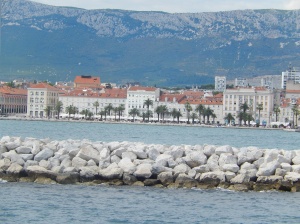


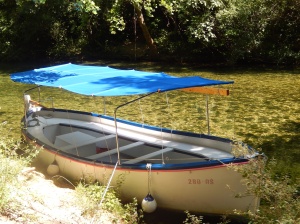


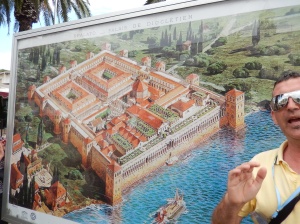
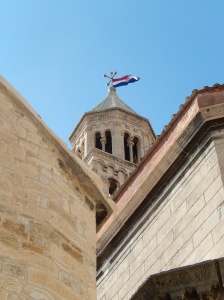
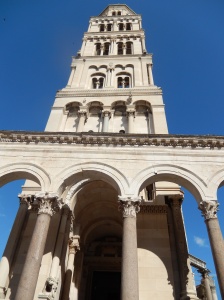
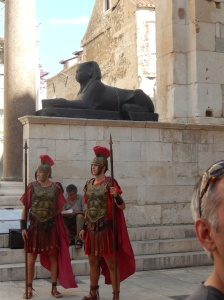
Oh wow weather looks fabulous!! Keep on enjoying
LikeLike
We have been so lucky with the weather! GG
LikeLike
Wish I was there
LikeLike
It certainly is a great odyssey!
LikeLike
Like you say: “This is the life.” What a wonderful journey and description thereof. I so enjoy travelling along with you Gwendoline.
LikeLike
You are so sweet Jolandi. Your support warms me. I hope we may meet when we reach Abu Dhabi (in September), GG
LikeLike
Let me know when you will be here. It would be lovely to meet. Now that it is summer here, and being outside is unpleasant, I especially love travelling with you. You are travelling in a part of the world I do not know much about, so I am loving every moment.
LikeLike
We will be travelling through places which are now known as Central Europe but were once behind the Iron Curtain. I won’t tell the details now as it will spoil the unfolding of the journey. But I am glad you are enjoying the follow and hopefully feel a part of the journey. We will be AD from evening of 14th Sep for four nights.
LikeLike
Please remind me closer to the time, and I promise to make a plan. In the meantime enjoy every moment of this exceptional journey.
LikeLike
Will do 🙂
LikeLike